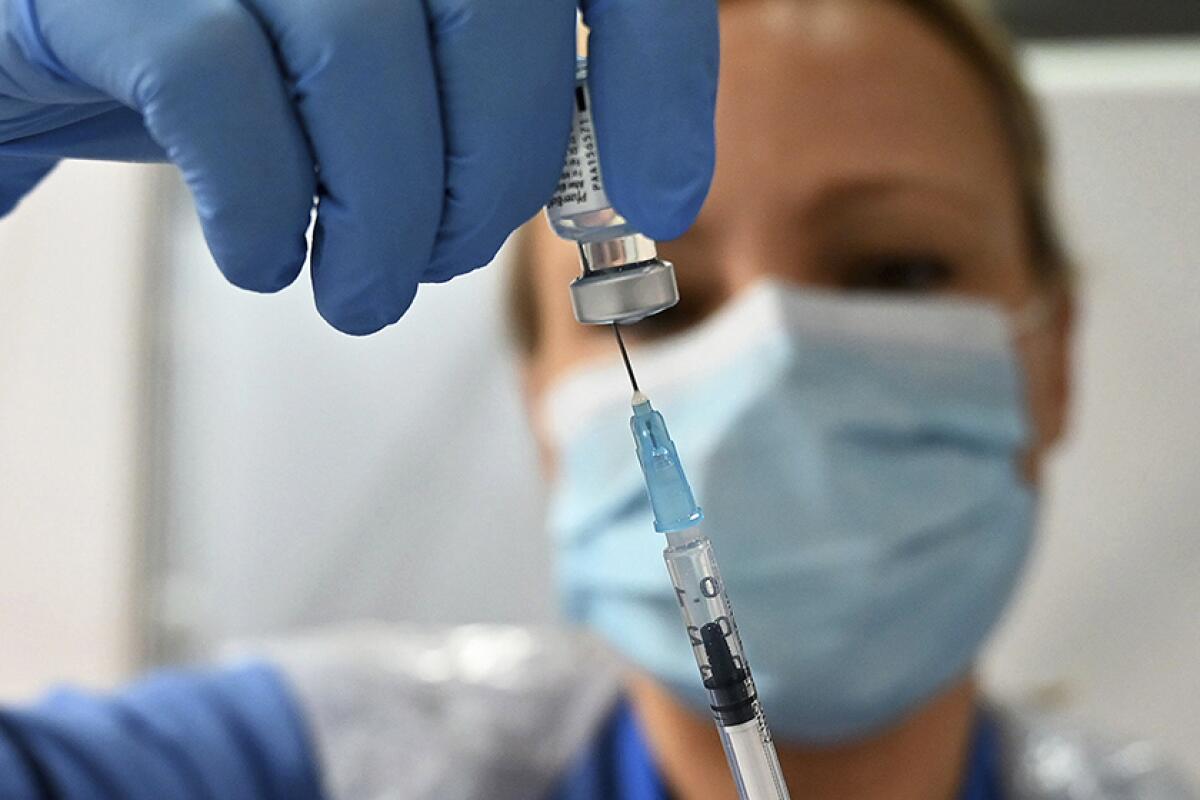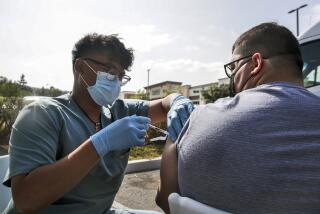Stanford ‘neglecting its front-line workers’ in COVID-19 vaccine rollout, doctors say

- Share via
SAN FRANCISCO — Stanford Medical Center doctors who are completing their residencies and fellowships staged a protest Friday, saying they were passed over during the first wave of COVID-19 vaccinations even though they work directly with patients who have the highly contagious disease.
A few dozen of the residents and fellows carried signs at the demonstration outside a door where the Palo Alto hospital was staging a photo opportunity for journalists covering the initial vaccinations. One protest sign read: “I saw 16 Covid patients in the last 24 hours ... More than Double the amount of residents getting the vaccine.”
Some doctors took to Twitter to protest the vaccine distribution plan.
“Disparities in distribution of the vaccine can be seen at a micro-level at Stanford today,” tweeted Dr. Christine Santiago, an internal medicine resident. “I worry that the situation we see at Stanford is a harbinger of population-level inequities of vaccine distribution for our underserved communities.”
Another Stanford resident, who asked to remain unidentified because of fear of retaliation, said only seven of about 1,300 residents and fellows were slated to receive the vaccine during an initial distribution of 5,000 doses. Some critical care and infectious-disease doctors also were passed over, the resident said.
On the other hand, some attending physicians who have been working from home and have not seen a COVID-19 patient in person since the pandemic began were slated to receive the inoculations, the resident said.
“Stanford hospital is neglecting its front-line workers in their vaccination plans,” the resident said. “The 5,000 vaccines went to [attending physicians] and many non-front-line workers, including those who have been working from their couches and haven’t touched an N95 [mask] for the past nine months.”
Dr. Niraj Sehgal, Stanford’s chief medical officer, apologized to the doctors who were not included.
“Despite our best intentions to thoughtfully map out a principled vaccine plan to include our residents, fellows, and faculty, it’s clear there were several unintended missteps,” Sehgal said in an email this week. “Please know the perceived lack of priority for residents and fellows was not the intent at all.”
Sehgal said the hospital was anticipating receiving more vaccine doses next week. “We’re increasingly confident in getting everyone vaccinated, including all of you,” Sehgal said.
The physician resident who spoke to The Times said the problem appears to be an algorithm that missed front-line responders when the vaccination plan was formed.
Residents and fellows, who are working to complete their medical education, tend to be in their 20s or 30s, an age group that is considered relatively safe from COVID-19’s most serious effects. But the resident said in an interview that patients in their 30s at Stanford have died of the disease, and some residents and fellows live with their parents, who are at higher risk.
“My resident colleagues have been getting COVID,” the resident said. “We’ve been given no direction or promise as to when we will be vaccinated. It feels like a slap in the face after 10 months of long, relentless work.”
Some other physicians, including full-fledged doctors who work in intensive care, also did not make the vaccine list, the resident said.
A representative for the hospital said Stanford Health Care took “complete responsibility for the errors in the execution of our vaccine distribution plan.”
“Our intent was to develop an ethical and equitable process for distribution of the vaccine,” said spokeswoman Lisa Kim. “We apologize to our entire community, including our residents, fellows and other front-line care providers who have performed heroically during our pandemic response.”
She said Stanford would immediately revise the distribution plan.
More to Read
Sign up for Essential California
The most important California stories and recommendations in your inbox every morning.
You may occasionally receive promotional content from the Los Angeles Times.














